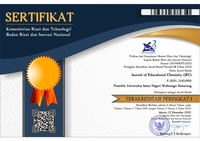Respon Mahasiswa terhadap Pembelajaran Interaktif dengan Animasi 3D melalui Powerpoint
DOI:
https://doi.org/10.21580/jec.2020.2.2.6401Keywords:
animasi 3D, media pembelajaran interaktif, persepsi mahasiswa, powerpointAbstract
Pembelajaran harus di dukung oleh dosen yang kreatif untuk menciptakan media pembelajaran interaktif agar mahasiswa lebih aktif, kreatif dan inovatif selama proses pembelajaran berlangsung. Tujuan dari penelitian ini adalah untuk mengetahui respon mahasiswa terhadap mediapembelajaran interaktif yang digunakan oleh dosen dengan menerapkan animasi 3D melalui Powerpoint, penelitian ini adalah penelitian deskriptif, penelitian ini dilakukan di universitas musamus jurusan pendidikan kimia. Sampel dalam penelitian ini terdiri dari 20 orang mahasiswa. Pengumpulan data dilakukan melalui google form yang dapat diakses oleh masing-masing mahasiswa. Berdasarkan hasil penelitian yang dilakukan mahasiswa memberikan respon yang positif terhadap animasi 3D yang digunakan oleh dosen dengan nilai 4,5 dari 5.0 dan dikategorikan sangat baik. Sehingga media pembelajaran interaktif dengan menggunakan animasi 3D melalui powerpoint dapat digunakan untuk menjadikan mahasiswa termotivasi untuk belajar di dalam kelas dan membantu pemahaman mahasiswa terhadap materi yang diajarkan oleh dosen.
Downloads
References
Haryati, S., Miharty, & Pratiwi, R. (2013). Pemanfaatan Media Animasi dalam Pembelajaran Kimia. Semirata 2013 FMIPA UNILA (363-368). Lampung: FMIPA Universitas Lampung.
Inman, C., Wright, V. H., & Hartman, J. A. (2010). Use of Second Life in K-12 and Higher Education: A Review of Research. Journal of Interactive Online Learning, 9 (1), 44–63.
Li, T. M. H., Chau, M., Wong, P. W. C., Lai, E. S. Y., & Yip, P. S. F. (2013). Evaluation of a web-based social network electronic game in enhancing mental health literacy for young people. Journal of Medical Internet Research, 15 (5). https://doi.org/10.2196/jmir.2316
Lu, L. (2013). 3D Virtual Worlds as Art Media and Exhibition Arenas: Students’ Responses and Challenges in Contemporary Art Education. Studies in Art Education, 54 (3), 232–245.
Madar, A. R., & Hashim, M. N. (2011). Effectiveness of Using Graphic Animation Courseware for Students With Different Cognitive Styles and Spatial Visual Abilities. Journal of Technical Education and Training, 3 (1), 47–58.
Marpaung, D. N., Siregar, L. F., & Pongkendek, J. J. (2020). Effect of using chemsketch on teaching molecular shape of hydrocarbon to increase student’s achievement. Journal of Physics: Conference Series, 1569(4). https://doi.org/10.1088/1742-6596/1569/4/042101
Marpaung, D. N. (2019). Implementation of Active and Creative Learning Through Multimedia on the Teaching of Solubility and Solubility Product. Journal of Basic and Applied Scientific Research, 9 (6), 42–46.
Mikropoulos, T. A., & Natsis, A. (2011). Educational virtual environments: A ten-year review of empirical research (1999-2009). Computers and Education, 56 (3), 769–780. https://doi.org/10.1016/j.compedu.2010.10.020
Musa, S., Ziatdinov, R., & Griffiths, C. (2013). Introduction to computer animation and its possible educational applications. New Challenges in Education. Retrospection of History of Education to the Future in the Interdisciplinary Dialogue among Didactics of Various School Subjects, 1–25. http://arxiv.org/ftp/arxiv/papers/1312/1312.1824.pdf
Riyanto, R. (2015). Pengembangan Modul Interaktif pada Pembelajaran Genetika untuk meningkatkan Hasil Belajar dan Pemahaman Konsep Siswa SMA Islam Batu. Jurnal Edukasi Matematika Dan Sains, 3 (2), 25-34.
Riyanto, R., & Susilawati, L. (2019). Penerapan Media Aurora Animasi 3D Maker untuk meningkatkan Hasil Belajar Kognitif Mahasiswa Biologi IKIP Budi Utomo Malang. Edubiotik : Jurnal Pendidikan, Biologi Dan Terapan, 4 (1), 52–57.
Rusman, Kurniawan, D., & Riyana, C. (2013). Pembelajaran Berbasis Teknologi Informasi dan Komunikasi. Bandung: PT RajaGrafindo Persada.
Sin, N. M., & Al-Asmari, M. A. M. (2018). Students’ Perception on Blending Instructional 3D Animation in Engineering Courses. International Journal of Information and Education Technology, 8 (5), 358–361. https://doi.org/10.18178/ijiet.2018.8.5.1063
Sugyono. (2015). Metode Penelitian Pendidikan Pendekatan Kuantitatif, Kualitatif, dan R&D. Bandung: Alphabeta.
Sugyono. (2015). Penelitian Kualitatif dan Kuantitatif. Bandung: Alphabeta.
Wahyuni, S., Amda , A., & Zakiyah, H. (2018). Pengaruh Penggunaan Media Animasi pada Materi Larutan. Jurnal IPA dan Pembelajaran IPA, 2 (1), 21-28.
Zare, A. Z. (2011). High Resolution 3D Animations as a Supplement for the Teaching of American Sign Language. In ProQuest Dissertations and Theses. https://search.proquest.com/docview/1022636181?accountid=14505%0Ahttps://ucdavis-primo.hosted.exlibrisgroup.com/openurl/01UCD/01UCD_SP?url_ver=Z39.88-2004&rft_val_fmt=info:ofi/fmt:kev:mtx:dissertation&genre=unknown&sid=ProQ:Dissertations+%26+Theses+%40+Univ
Downloads
Published
How to Cite
Issue
Section
License
The copyright of the received article shall be assigned to the journal as the publisher of the journal. The intended copyright includes the right to publish the article in various forms (including reprints). The journal maintains the publishing rights to the published articles.
Authors are permitted to disseminate published articles by sharing the link/DOI of the article at the journal. Authors are allowed to use their articles for any legal purposes deemed necessary without written permission from the journal with an acknowledgment of initial publication to this journal.

This work is licensed under a Creative Commons Attribution-NonCommercial-ShareAlike 4.0 International License.



